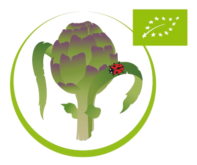
The The artichoke field Agostini has been named by the Marche Region and by the Ministry of Agricultural, Food and Forestry Policies as "Farmer Guardian of the Organic Montelupone Artichoke".
We have been identified as a farmer who is the custodian of genetic resources of local food and agricultural interest, animals and plants, risk of extinction and genetic erosion.
Guardian farmers, together with the germplasm bank, constitute a point of excellence in the area for the conservation, information and dissemination of native genetic material to protect and enhance biodiversity of agricultural and food interest.
These farmers are those who commit themselves to the conservation, in the context of the farm or in situ, of the genetic resources of local food and agricultural interest subject to risk of extinction or genetic erosion, according to the procedures provided by the disciplinary for the keeping of genealogical books or registry records pursuant to the law of 15 January 1991, no. 30, and to the legislative decree 30 December 1992, n. 529, and the regional provisions issued on the matter.
In the definition of custodian farmers and breeders (AAC), farmers and breeders are active subjects in the process of adaptation and evolution of the variety / plant and animal populations, which commit themselves to maintaining the time of this evolutionary cycle, which positively affects the cultivated and bred biodiversity and therefore on the diversity of food.
They are essentially custodians of an evolutionary process, linked to a collective good (varieties and populations) which is imbued with knowledge, techniques, uses and customs in which they are not the owners.
They can be public and private subjects, in single or associated form that they commit to keep "in situ/on farm"The local resources at risk of extinction or genetic erosion, registered in the national register of biodiversity of agricultural and food interest.
For conservation "in situ/on farm" means the provisions of the guidelines for the conservation and characterization of plant, animal and microbial biodiversity of interest for agriculture.
- CONSERVATION IN SITU (In situ conservation): is the conservation of ecosystems and natural habitats and the maintenance and recovery of specific, vital populations, in their natural environment or, in the case of domesticated or cultivated species, in the environment in which they have developed their distinctive characteristics. It is a 'dynamic' conservation system, because it is subjected to selective environmental pressure, determined by biotic (including man) and abiotic factors.
- ON FARM CONSERVATION (On farm conservation): it is in fact a conservation in situ. The term mainly refers to the populations of animal and vegetable species cultivated / bred continuously on the farm. In this case, the essential role played by farmers in the creation, use and safekeeping of genetic resources and the link with culture (in
a broad sense) of the human populations that developed them.
Custodian farmers and ranchers' commitments (AAC):
Guardian Farmers and Breeders (AAC) undertake to:
- provide for the evolutionary maintenance by cultivation and breeding of at least one genetic resource of local food and agricultural interest, vegetable or animal subject to risk of extinction or genetic erosion registered in the National Registry;
- spread, as far as possible, the knowledge, use and traditions related to the genetic resources of which they are custodians, following the principles of the law of 1st December 2015, n. 194 of the genetic resources registered in the national registry;
- activate a reciprocal exchange (through an agreement / memorandum of understanding / collaboration) with at least one ex situ conservation center and / or a germplasm bank that conserves the same genetic resource. This in order to activate a complete conservation (in situ / on farm and ex situ) also through exchange of knowledge;
- contribute, if necessary, to the renewal of the seed / multiplication material kept at the ex situ conservation center and / or the germplasm bank itself;
- not to request a patent on the genetic resource kept, nor to transfer it to others who express their intention to request it;
- undergo a system of control and verification over time (at least for the duration of the commitment), of the real presence of the genetic resource for which the recognition of AAC was requested and of its correct conservation "in situ / on farm".
The requirements of custodian farmers and ranchers
Public and private individuals, individually or associated, located in the national territory, who formally undertake the commitments referred to in point 3 above and who are in possession of the following requirements, can be recognized as Farmers or Breeders custodians (AAC).
- availability of at least one genetic resource registered in the national registry;
- regular possession of land or suitable facilities for breeding on the basis of a valid title;
- specific professional experience or ability in one or more of the following areas:
- cultivation and reproduction of plant genetic resources of local food and agricultural interest subject to risk of extinction or genetic erosion;
- breeding of animal genetic resources, of local food and agricultural interest subject to risk of extinction or genetic erosion.
The Network is coordinated by the Ministry, in agreement with the Regions and with the Autonomous Provinces of Trento and Bolzano. Therefore, the Ministry formalizes the recognition of Farmers and Breeders Caretakers (AAC) and the adhesions to the National Network of the subjects entitled, after verifying the presence of the positive opinion of the Regions, by publishing on the Portal. the presence of the positive opinion of the Regions, through publication on the Portal.
